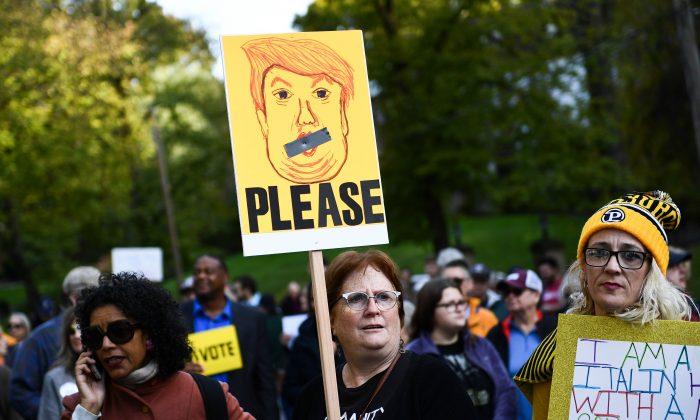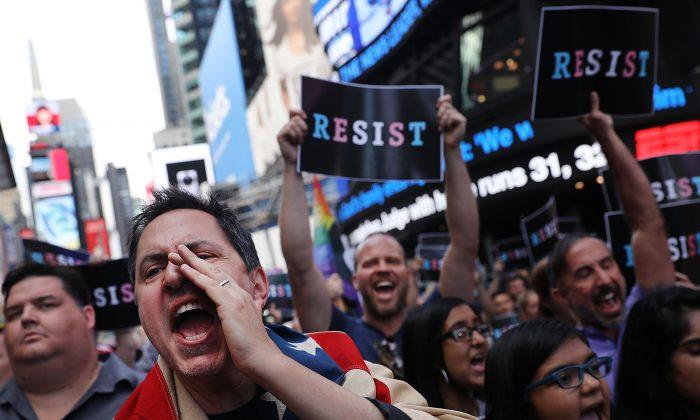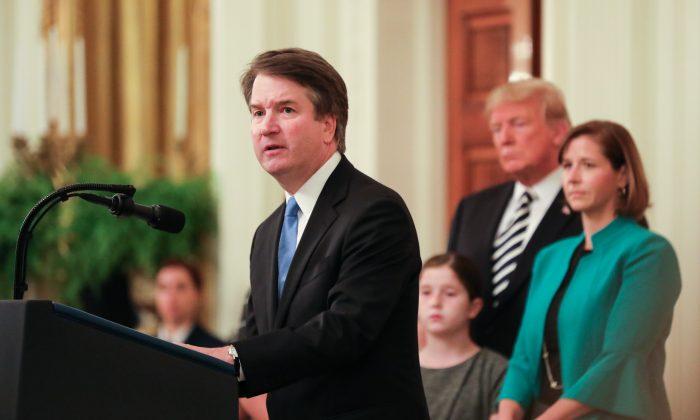Unlike most other mass shootings in America, the slaughter of 11 Jews at Pittsburgh’s Tree of Life synagogue in late October 2018 did not trigger demonstrations against the National Rifle Association or calls to curtail Second Amendment freedoms. Instead, it triggered an orgy of blaming and shaming of the people and the social forces that were said to have instigated it.
First, blame was directed toward the “toxic” rhetoric President Donald Trump was said to have used on Twitter to warn about invading immigrant hordes, which was alleged to have set the stage for the attack. Then, it was directed toward the torrents of “online hate” that had overtaken social media and had animated the crazed Jew-hating gunman to barge in during Saturday services and start blasting.
In kindergarten, Americans learn that “sticks and stones may break my bones, but words will never hurt me.” In the new digital dispensation, however, it’s worth asking whether that old childhood chestnut still applies. To many, especially aggrieved or beset U.S. minority groups obsessed with “cyber-hate” and online “microaggressions,” it seems that words will ever hurt you.
Before the blood had even dried on the floor, the Pittsburgh massacre was cited as proof that social media companies had irresponsibly allowed online hate to fester on their various platforms, and that free speech protections needed to be curtailed in light of the rising tide of anti-Semitism that digital incitement had fueled.
Big Tech and Journalism
Since the 2016 election, civil liberties groups such as the Southern Poverty Law Center (SPLC) and the Anti Defamation League (ADL) have been operating in tune with the first principle of the Resistance: that there should be “no platform for fascists.” Both groups have devoted a lot of their energies to blacklisting people they find objectionable, wildly exaggerating both their offensiveness and the level of threat they represent to eliminate political pushback against their agendas and to enhance fundraising.These groups have also forged partnerships with Big Tech platforms that were already ideologically sympathetic with them and already predisposed to marginalize political, cultural, and ideological views at odds with the dominant pro-diversity, pro-multicultural politically correct consensus within their organizations.
In the liberal monocultures of these Big Tech entities, views and causes that are politically distasteful or threatening need to be suppressed, often through the manipulation of algorithms and content moderation with little accountability or transparency built into the process.
In the past, the American Civil Liberties Union (ACLU) could have been counted on to hold up the banner of free speech high and loud. But the ACLU, mindful of its donor base, has been pretty tepid, refusing to call out the ADL and the SPLC by name. The ACLU is more interested these days in multicultural advocacy than upholding constitutional protections for free speech, the right to free assembly, and free thought.
Many of the appeals to limit internet free speech, however, have come from journalists in the mainstream media.
Like much in the age of Trump, it made for an upside-down, inside-out moment, with journalists who should have been going into battle for free speech actually saying that the First Amendment as it has been traditionally understood might be a threat, even as they grow hoarse condemning Trump for deriding the media as the “Enemy of the People.”
Journalists who once fought blacklisting and censorship are now embracing it, or mumbling that these things must be seen in the context of spreading right-wing authoritarianism and the struggle against “racism, nativism, misogyny, and xenophobia.”
There is a mistaken assumption at the bottom of this that you can somehow purge or contain acts of isolated extremist violence on the part of a few by limiting the free speech of the many, whether they are on the main platforms or minor ones like Gab—completely anti-utilitarian.
Dystopian Direction
In many ways, Big Tech is already Big Censorship, with Google discussing ways in which it can become “The Good Censor,” Twitter banning those unfortunate enough to become the target of online vigilante mobs, and Facebook shutting down pages of people after an algorithm has identified them as dangerous or insulting.This has already moved us in a dystopic direction, into the realms of “Nineteen Eighty-Four,” “Brave New World,” and “Minority Report”—the world of thought crimes and precrimes, with people afraid to state their views because they have no idea what will bring them under suspicion, cut them off from modern modes of communication, or put them in jail.
Post-Pittsburgh, calls for censorship represent a kind of digital putsch to gain control over social media platforms in the same way that multicultural orthodoxy gained earlier control over the mainstream media, academia, and Hollywood.
The kind of internet censorship they’re proposing is said to be aimed at bigotry and hate. But in the hands of Big Tech, it will short-circuit legitimate policy discussion, especially by those who can in any way be labeled—or mislabeled—as racist, sexist, nativist, xenophobic, or misogynistic.
This new digital censorship is at odds with the current nationalist moment. It represents an effort on the part of globalist corporations to impose global speech codes at exactly the point that a large part of the American electorate simply and clearly said “no to globalism”—and an increasing number are seeing that the sky will not fall if they do.
Whistleblowers
Back in 2010, when WikiLeaks first released data from Afghanistan stolen by U.S. Army whistleblower Bradley (now Chelsea) Manning, I was opposed, concerned about dissident actors taking matters of intelligence and national security into their own hands. The same when Edward Snowden made his disclosures about unauthorized NSA wiretapping and abuses of the FISA warrant process.But in the face of widening state surveillance of private citizens through various digital communications networks (whether you call that Deep State surveillance or not) and in the face of increasing abuse of privacy by big digital platforms, I have come to a new admiration for people such as journalist Glenn Greenwald, who enabled both whistleblowers. I will throw my lot in with him, here at any rate.
“Our discourse, our newsrooms, and our academic institutions are now drowning with people who demand that any speech be banned and suppressed that they regard as ‘hurtful,’ ‘offensive,’ ’traumatizing,‘ or fostering a feeling of being ’unsafe.‘ But what they really mean is that they want speech suppressed that they and those who agree with them find ’hurtful‘ and ’traumatizing.’ Speech that makes their political enemies feel offended, uncomfortable or unsafe is heralded as brave and provocative.
“That double standard is unsustainable. It’s empty and depraved. It is certain to consume not just one’s political enemies but also one’s political allies. ... Censorship advocates reap what they sow, and it usually ends up consuming them and their own allies. It may be karmic justice, but it does massive damage to the ability to have free discourse, the right of dissent, and the flow of unpopular views.”
Part two in this series will focus on developments inside Big Tech companies and points where America’s most cherished national traditions, i.e., the rights to free speech and the rights to free assembly, are being sacrificed to advance the globalized interests of Big Media and Big Tech with the assistance and guidance of entities other than the U.S. government. Part Three will examine the faulty cultural, journalistic, and ideological assumptions behind all this, and how efforts to curb online hate, specifically anti-Semitic online hate, might actually encourage more of it instead.




